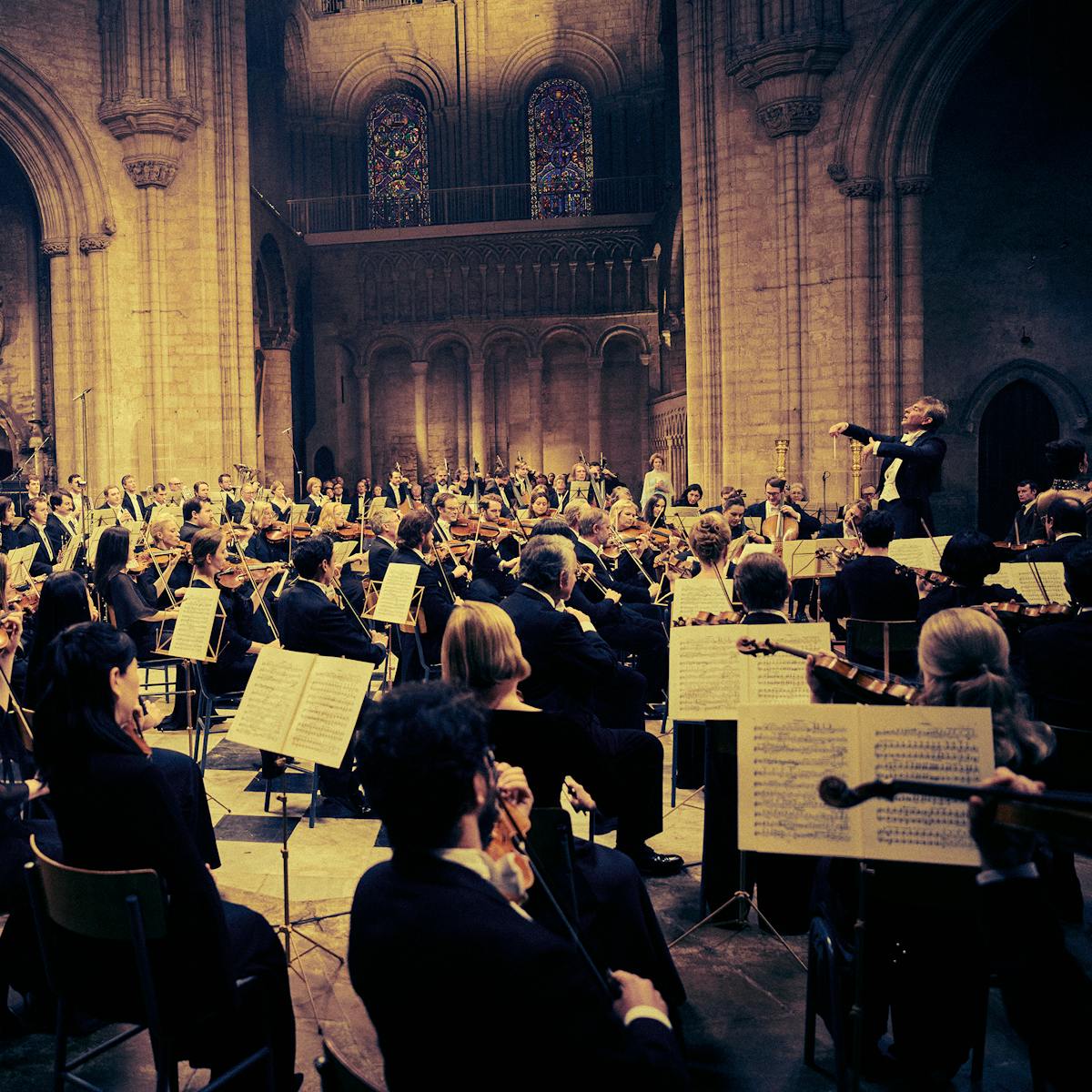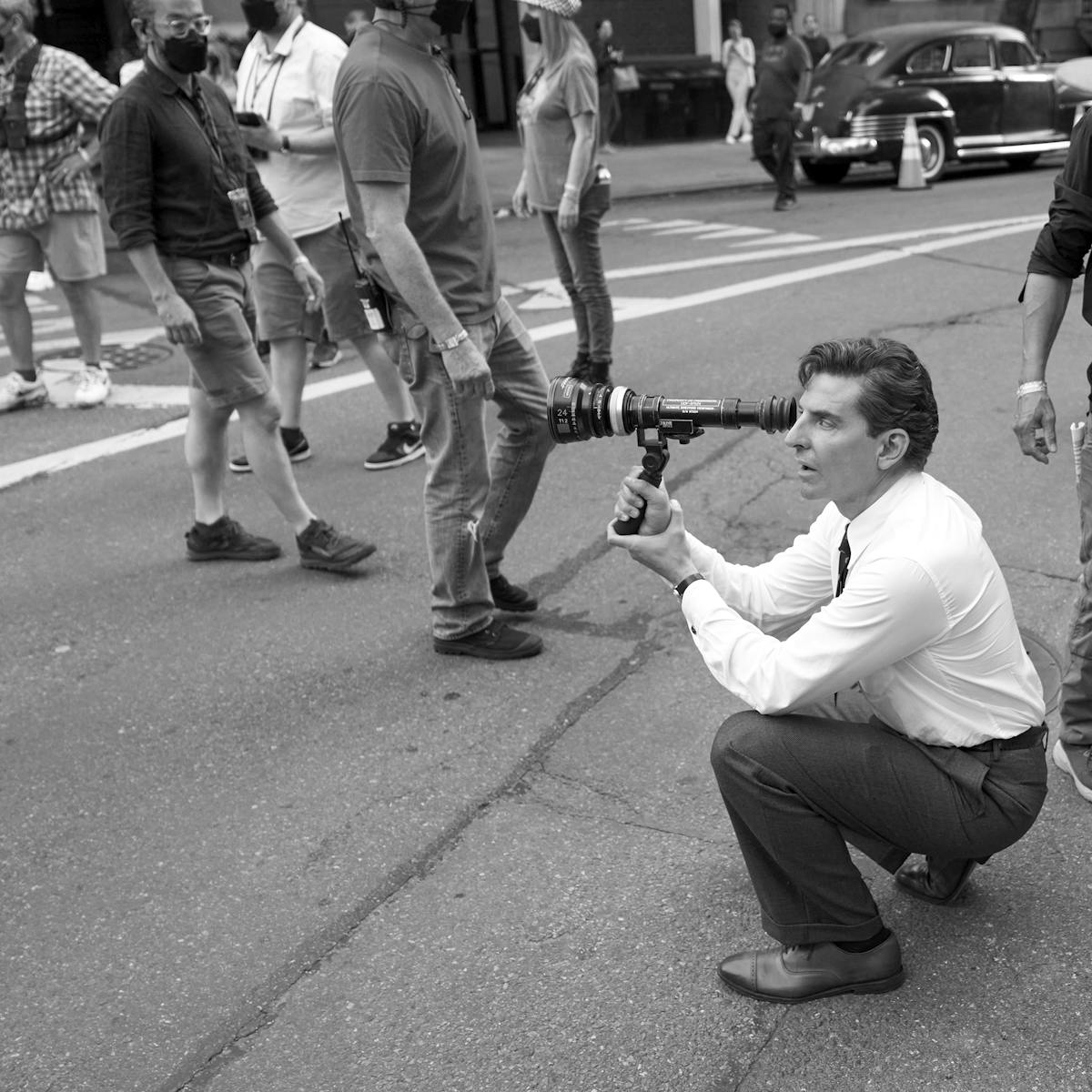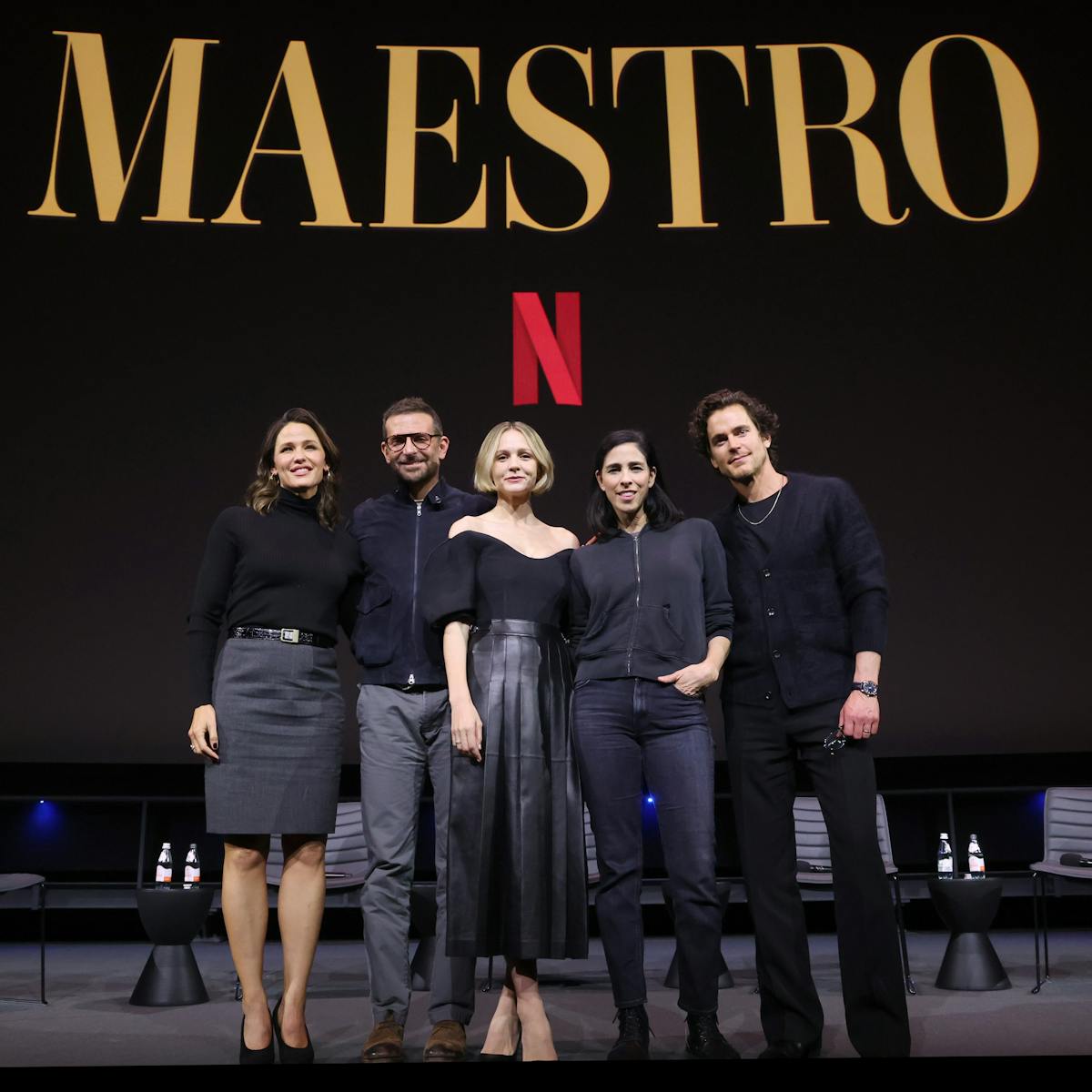One auteur to another, Guillermo del Toro asks Bradley Cooper about wearing many hats on his sophomore film.
When Bradley Cooper first told his close collaborator and friend Guillermo del Toro about the idea for his latest film, Maestro, it was in the most unlikely of places: on Cooper’s own roof. “I hated that,” laughs del Toro. “He says, ‘Do you mind if we talk on the roof?’ ‘No. I don’t,’ but I did.”
The two filmmakers had gathered at Cooper’s home to discuss another project, del Toro’s Nightmare Alley, which Cooper both starred in and produced. Unconventional locale aside, Cooper began to share his vision for exploring the lives and marriage of legendary conductor and composer Leonard Bernstein and his wife, the actor and artist Felicia Montealegre Cohn Bernstein, played by Carey Mulligan. Maestro, a project in which Coopers acts, directs, co-writes, and produces, explores nearly half a century of Leonard’s life, from his first unexpected outing as conductor of the New York Philharmonic at age 25 in 1943 to the coda of his life in the late 1980s, spent at Tanglewood and the Bernstein family home in Fairfield, Connecticut.
Cooper brought his expansive vision to life with a singular team of craftspeople, including cinematographer Matthew Libatique, production designer Kevin Thompson, costume designer Mark Bridges, editor Michelle Tesoro, and prosthetic makeup and hair designer Kazu Hiro. In addition to six years of research on the Bernsteins, Cooper spent up to six hours in the makeup chair daily to wholly transform into the conductor. “I’ve always dreamt about ways of telling [a] story. It’s something that’s always been inside me,” Cooper tells del Toro. “Because you believed in me as a filmmaker, that really meant everything to me, and it allowed me to be bold enough to try to tackle these ambitious compositions.”
“You were there every day, whether you were [in] the scene or not. We were like twins,” remembers del Toro of working together on Nightmare Alley. “One from the shallow end of the D.N.A. Another one, slightly more fortunate, but twins nevertheless, like DeVito and Schwarzenegger.”
The two directors reunited, following a screening of Maestro at the historic Egyptian Theatre, for a candid and in-depth conversation on the rhythmic, cinematic choices of Cooper’s romantic drama.
An edited version of the conversation follows.

Felicia Montealegre Cohn Bernstein (Carey Mulligan) and Leonard Bernstein (Bradley Cooper)
Because it’s a movie about marriage and a relationship, it was going to have to span decades. That was the only way to tell this story. That meant, how do we shoot the 40s, 50s, 60s, 70s and 80s? It’s going to have a different aesthetic because we wanted you to be immersed in the film.
Bradley Cooper

Leonard Bernstein (Bradley Cooper) and Felicia Montealegre Cohn Bernstein (Carey Mulligan)
Guillermo del Toro: We started to talk about Maestro, what, seven, six years ago?
Bradley Cooper: Yeah. We started talking about it when we first started talking about Nightmare Alley. I remember we were on the roof of my house.
GDT: Yeah, we went off, we talked about it, and I said, “Can I read it?” And I read it. And many of the shots that are in the movie were described already on the paper. Tell me a little bit about that certainty, because you knew you needed to get a completely fresh approach that was very orchestral, symphonic, down to the camera mode. [It’s] agile, beautiful camera work that you did in this movie.
BC: The truth is I learned a tremendous amount of that from you, maestro. I had never seen somebody use a Technocrane like it’s a hand-held camera. Truly, the way you conducted that Technocrane, I really learned how it could be such a wonderful weapon in the arsenal of filmmaking. I completely digested that and was able to have that as an incredible magical wand for us in the film. And that’s all because of you.
From the beginning, I knew two things: I wanted to make a movie about a marriage, and I wanted there to be a musical element — those were my north stars. Because it’s a movie about marriage and a relationship, it was going to have to span decades. That was the only way to tell this story. That meant, how do we shoot the 40s, 50s, 60s, 70s and 80s? It’s going to have a different aesthetic because we wanted you to be immersed in the film. Like music, you press play, the music starts, and you’re in it until the music ends. And that’s how the film had to be. That was the only way to do justice to Lenny because that’s what he did with his music. His music is the film; his music is a character in the film. So, I had all of these guiding north stars, and because of people like you, I had the tools that I had learned, to a degree, to explore, in order to help tell it in that way.
GDT: There [are] a lot of things you [had] very clear in your mind that were remarkable. Like, the first big shot [following] him from the bedroom to the hall and across the roofs. We were talking about, how are you going to [create] it?

Carey Mulligan and Bradley Cooper
BC: That first sequence did come into my mind very early on. It was one of the sequences that I would pitch to studios. I had already had that in my head, so, I was able to work early on with Matty Libatique, the cinematographer, and Mango [John Mang], who’s, in my mind, one of the best dolly grips in the world, and Scott Sakamoto, a wonderful camera operator. We would sketch out how we were going to do this because everything was practical and we had permission to shoot in Carnegie Hall; just walking in there was exciting.
It’s one single shot that then, as he goes through the threshold onto the box, that’s the cut. And we had to mask the 12-and-a-half inches. And then, we did a cable cam down that goes to the podium, then pushes him back up. And then that leads to him coming up — originally I was going to put [the camera] on a cart and just have it handheld. And then Scott Sakamoto was like, “No. I can do this with the steady cam and it’s going to be smoother.” He was right.
GDT: You are a director who acts. That’s the truth. The way you think, even when you’re acting, I could tell you the lens and you would say, “Do you want me to do this on the edge of the frame?” The way your mind thinks is a directorial mind. I really love the way you think about it. You have to feel that great camera move because you want to feel the great excitement of that moment when he gets from a bedroom to the hall. How vertiginous.
BC: Well, it’s all [in service] to story. That’s the thing. There’s nothing that takes one out of a movie more than recognizing the camera shot as it’s happening. The hope is you feel something. The compositions had to be bold, the filmmaking had to be bold because the subject matter is so bold; the character of Lenny is so bold. That’s the only way to do that justice. It was like, how do we tell a story of this guy who’s plucked from the heavens and his destiny is pulling him?
In a way, I think it’s easier to direct and act — as opposed to just direct and not act in it — because you’re on the field and you’re able to dictate things and save time. It’s so much easier to get other people to be as open as you are if you’re doing it too. If you’re willing to make a fool out of yourself in front of everybody, everybody else gets free to do it. I certainly was doing that every day by coming out of a trailer and, “Who the heck is this guy talking like this, smoking all day?” I mean, it’s crazy.
I felt so vulnerable because I was directing a film and I figured the crew’s like, “Jesus, this is nuts.” But they all believed in the illusion with me, and it was actually a beautiful experience. That scene when Felicia’s diagnosed with cancer and I’m hugging her — I said, “Make sure to push in once I come around and I’m going to do this thing where he engulfs her.” We see that tableau of him thinking he’s taking care of her, but it looks like he’s suffocating her. He does that after he comes off the stage. He does that in the bed at the very end, and he does that when she gets diagnosed with cancer. For some reason, I felt maybe Mango was backing up. And so as she’s crying and I’m hugging her, what I’m actually saying is, “Up. Up.” I’m like, “Mango, come up.” God bless Carey. She wasn’t like, “What did you just say? I just got diagnosed with cancer. Who’s Mango?”

Matthew Libatique and Bradley Cooper
GDT: It would be very easy for an actor, director, producer, or writer to simply mine Lenny and not understand the importance of Felicia in the story, or nurturing and loving a performance in such a beautiful way.
BC: Thank you. Well, that’s all due to her and me just being smart enough to keep the camera on her because she’s incredible. I love actors, as you do. I just love actors and I love watching actors at their craft at the highest level.
GDT: One of the decisions that we discussed early on was makeup effects, and I said to you, there’s only one guy.
BC: That’s right. God bless the master Kazu Hiro for not only his talent but his work ethic. Because what I asked of him was a lot. We spent years working on this. I basically moved into his house. I’m kind of not exaggerating.
The two and a half to five and a half hours before crew call every day when Kazu would do his work was an active process. I didn’t fall asleep in the chair. I would be like this and we would talk about it and we kept trying to improve it throughout the whole shoot. He was just such a wonderful partner. The truth is Lenny is not just me, it’s Kazu. We both play Lenny in the movie.
GDT: I didn’t hear from Kazu for a couple of weeks after you wrapped [Maestro], and I thought, “There goes my friendship.” But, you don’t know this: He wrote me a beautiful email thanking me for recommending him to you and saying how much he loved and grew and how much he felt he had created together with you since this work.
BC: Wow!
GDT: Let me ask you about the process of editing. You said, let us construct it not from the big moments of the biography, but the moments in the marriage, the moments in his own decisions, the moments in which he’s facing this or that. This is really remarkable, and I would love for you to talk about that.

Bradley Cooper, Matthew Libatique, and Carey Mulligan
BC: That really just comes from my own thoughts about my life. And so, the task first started with [co-writer] Josh [Singer] and us as writers piecing together moments of this relationship, so that you can come to a conclusion about your thoughts or feelings about it. That’s why we have that quote in the beginning of the movie from Lenny, that hopefully it provokes questions, not answers.
Moments are like notes. And notes, strung together in a melody, create music. That’s really how this film started to construct itself in my mind. I thought if we could potentially pull that off, we could get close to what it would be like to be inside his brain and his soul. And also, what it was like to watch this man conduct and compose. When I was researching, the other thing that was really interesting was people never said, “When Lenny and his wife would . . . ” It was always “Lenny and Felicia.” That’s how people remembered them. And that’s why they’re always sharing a frame, the whole movie. It’s always two of them.
My hope is that you actually feel like you know that person and you’re not watching this iconic, mythical figure. If you did love Leonard Bernstein or if you knew nothing about him, you’re watching the real person. Yeah. I guess Bradley looked kind of like him, you’re not thinking any of that. Hopefully, you’re going, “I know him.” That was the goal.
Watch the full conversation between Bradley Cooper and Guillermo del Toro.




